Watermelon is perfect ingredient to do taste science activities at home.
In this post, I shared my experience of performing watermelon experiments done with my children. Here is the list of experiments to explore:
- Create a Watermelon Volcano
- Learn Fractions – Math Activity with Watermelons
- Watermelon Sensory Play
- Shape Activities with Watermelon
- Taste Science Activity With watermelon
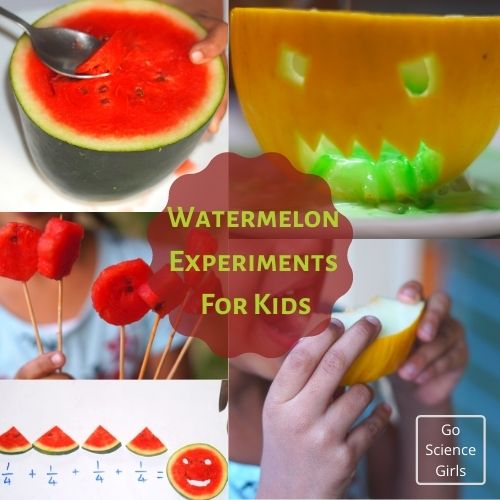
Suitable For..
These super cool activities are suitable for people of all ages as they can explore about amazing chemical reactions, simple science concepts, and sensory play.
Toddlers, kindergarten, pre-school, and elementary school children can enjoy this activity. Whereas older children and adults can enjoy and understand the science behind the activities with watermelon.
Watermelon Volcano Science Experiment
We are going to erupt a beautiful volcano inside the watermelon fruit using 2-3 ingredients and the instructions are also so easy to perform.
Note: Ask children to wear safety goggles and gloves before they start the experiment.
Besides, this activity leaves a little messy work on your experiment table. So, I prefer to perform this activity in your garden area or back yard or outdoor.
Ingredients you need
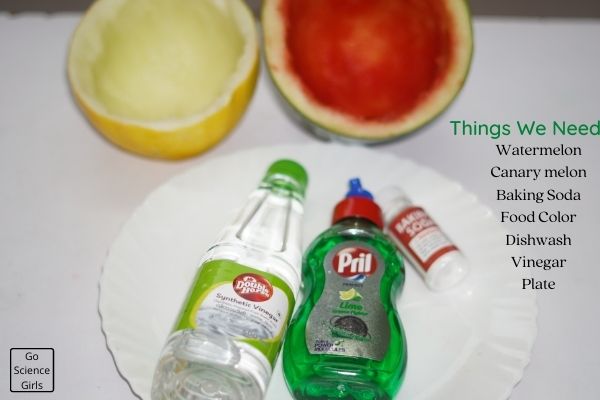
1) Baking Soda
2) Vinegar
3) Dish Wash
4) Food Color
5) Knife or any slicing tool
6) Watermelon (Regular and Canary melons)
Simple Step-by-Step Instructions
Step-1:
Pick two watermelons i.e. one regular means green from outside and red in color from inside and the other is canary or champagne watermelon means yellow in color from outside and warm white from inside.
You can see the pictures we attached in the post to learn the difference between regular and canary watermelons.

Step-2:
Once you pick the right shaped watermelons, slice them in to half. If you are not sure to cut the melon in two equal halves, then draw a circle exactly in the middle of the fruit using a pen or pencil.
Then, try to slice the melon using sharp knife in to two equal halves. Such that you will have two parts of one watermelon and in total four parts for two watermelons.
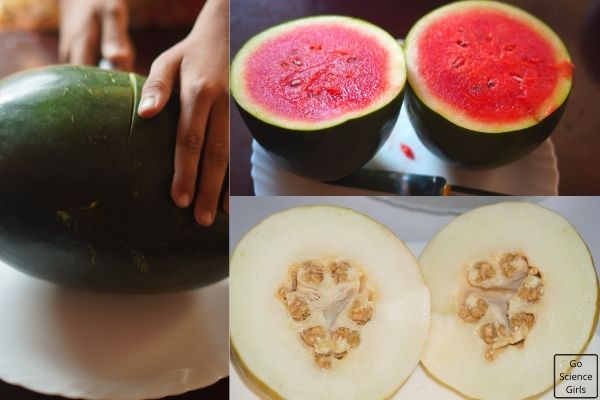
Now, scoop out the inside part of all the four parts of sliced watermelons neatly and completely.
Instead you can give your children to eat the juicy melon using spoon. Also, they can perform some sensory activities at this stage which I explained in further post.
My children Tisha and Prithika enjoyed the delicious and juicy melon and gave me the clean bowl shaped watermelon peel for the activity. Loll!!!
Step-3:
Ask your child to carve some funny faces on the watermelon peel with two eyes and a wide opened mouth as shown in the images attached.
My children are very much interested in carving stuff and they carved beautiful smiley and spooky faces on them.
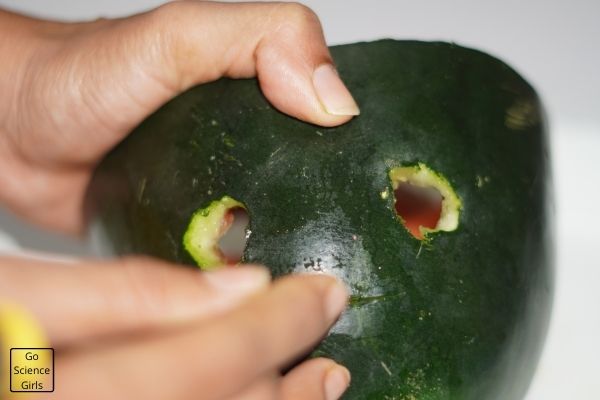
Step-4:
It is time to put our heroes of the activity into the picture. Ask your child to pour some amount of baking soda, food color and then dish wash soap into the watermelon rind.
Later as a last adding ingredient, pour little amounts of vinegar solution on top of the baking soda mixture inside water melon.
Once your child starts pouring vinegar you can observe the amazing chemical reaction happening between baking soda and vinegar.
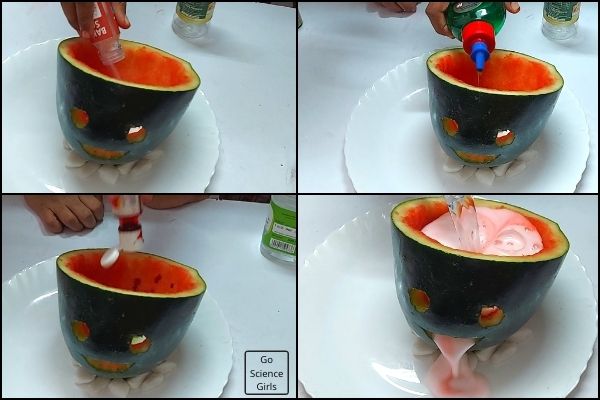
You can see the volcano eruption clearly coming out of the mouth part of the carving on watermelon. As we give food colors inside the water melon, we see volcano eruption beautifully coming out in color.
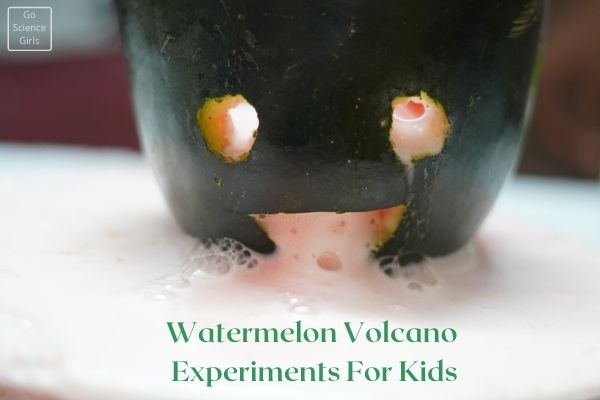
Step-5:
Repeat the same instructions from step-2 to step-4 with the canary or champagne watermelon. And enjoy the beautiful volcano eruption coming out of the melon carved mouth.
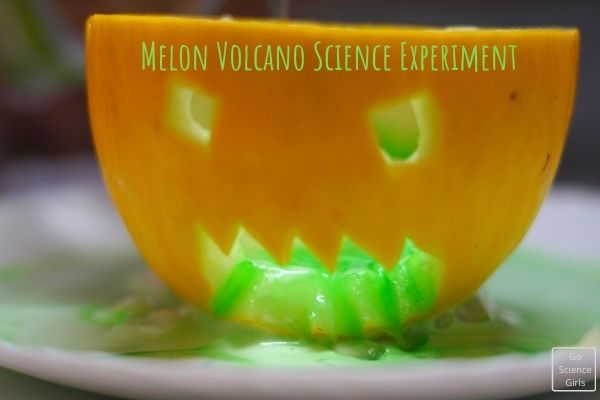
If you arrange light inside the melons, then you will have an eyes treat experience of watching watermelon volcano eruption. Give it a try!
Science involved in this Activity
The science involved in watermelon volcano eruption activity is the simple science you can hear and see. Let us see what exactly happening inside the watermelon!
When you pour enough vinegar solution inside watermelon, the already existing baking soda immediately reacts with vinegar and releases carbon dioxide.
Carbon dioxide is a colorless trace gas that naturally happens in the atmosphere due to various reactions. In this activity, the reaction between baking soda and vinegar makes carbon dioxide.
As there is some amount of dish wash soap, the carbon dioxide released makes bubbles within it and starts erupting. Hence, the eruption looks fizzy and bubbling.
My children enjoyed watching the fizzy watermelon volcano science activity a lot. Hope yours too!
Let us jump into the other simple activity with watermelon.
Watermelons and Fractions Math Activity
Are you a parent of a pre-schooler or home schooler whose academic curriculum demands to introduce your child to fractions in Math?
If so or even you are not asked for, you can perform this simple activity with your children during their play time and make learning math as fun as their play.
Materials Required
1) Watermelon
2) A Knife
3) White Ceramic Plate
That’s it! You do not require much to explain kids about fractions.
Instructions to learn Fractions with Watermelon
Step-1: Halves
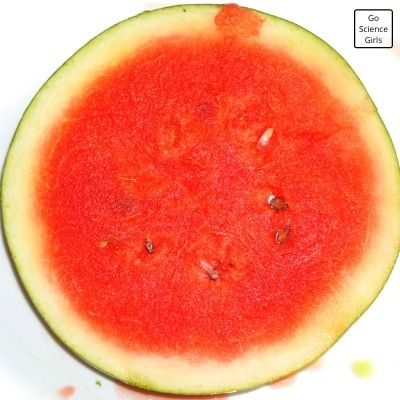
Pick a watermelon and slice two circular pieces out of it.
Keep one slice aside and start carving on the other slice. Children can carve any shape or figure of their choice.
My children carved smiley face on it. You can see the figures to get ideas. Then, cut the other slice into two equal halves.
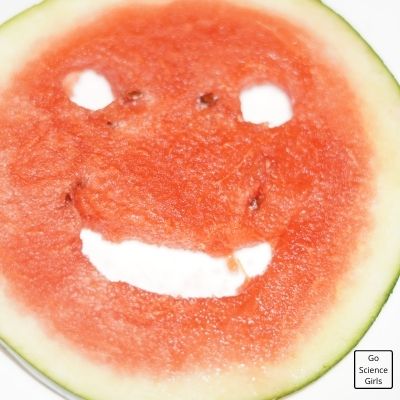
Now offer these slices to your children and let them try to make a whole circular slice like earlier ones. Some may complete the task and some may not.
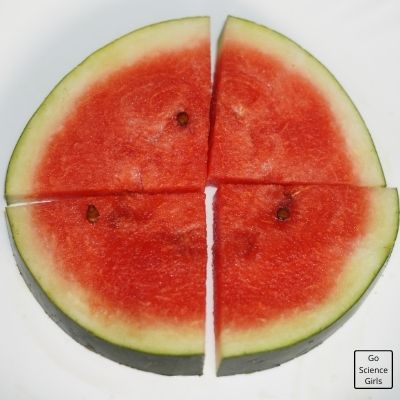
But do not worry, explain them about halves and combine the two halves and show them how a full is made using halves. Or either way, show them how a full is cut into two equal halves.
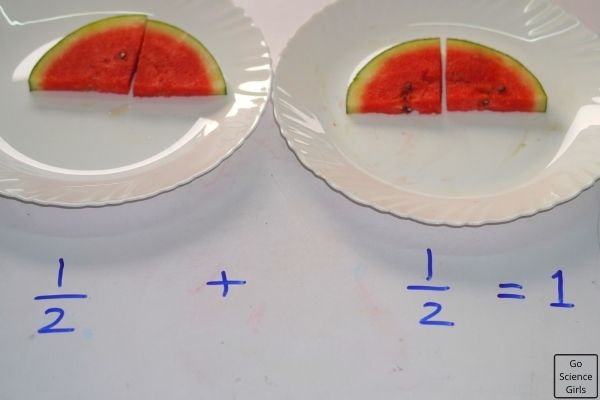
1/2 +1/2 = 1; I mentioned the same equation under the watermelon slices plate and explained about how halves and full forms mathematically.
Step-2: Quarters
Slice a circular melon and cut it into four equal parts as shown in the figures. Now, place them one after the other in the same row. Then, you give enough time to your child to make it a full slice as earlier.
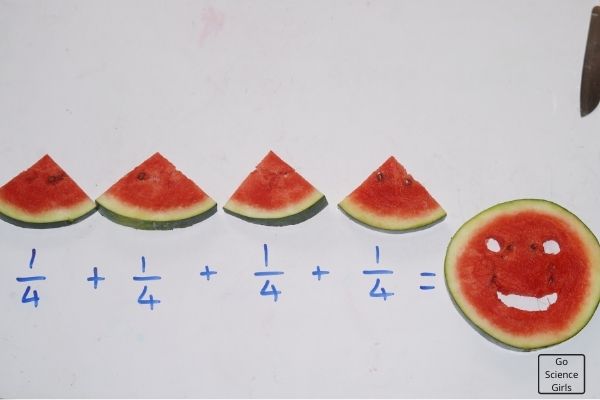
Once your child trials are done, you explain your child how quarters make a full slice visually.
1/4+1/4+1/4+1/4 = 1; in this way, arrange the four quarters and make a full slice
Step-3: Quarter + Quarter = Half
Using the same instructions from step 1 and step 2, you can explain your children about how two quarters make a half.
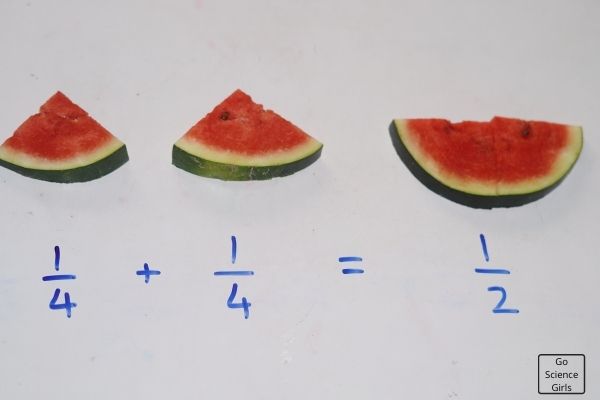
1/4+1/4 = ½; Arrange the two quarters according to the equation and make a half slice.
In this way, children can have an awesome visual experience in learning fractions without any confusion. Let us have a brief look at the benefits of learning fractions using watermelon slices. Here we go!
Benefits of Learning Fractions using Watermelon Slices
- Challenge your children to find out the equal parts. Also, talk about their names like halves, quarter, full, etc. Such that they will learn and remember the concept easily.
- Watermelon slices offer an awesome visual experience for children to play and learn about fractions. In addition, they never ever forget about how two halves, four quarters make a whole. And two quarters make a half plus three quarters make a 3/4th.
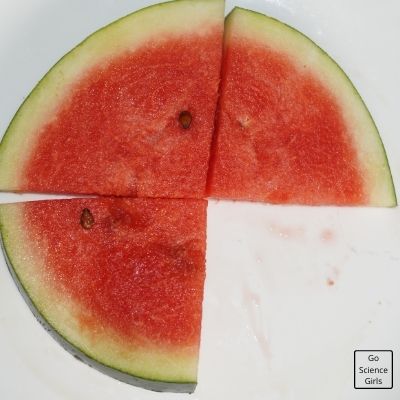
- You can have a great opportunity to discuss about the relative sizes of the melon. Also, teach your child about which fraction is greatest and smallest among all the slices of watermelon.
- Helps to build a strong foundation on equivalent and non-equivalent fractions.
- You can even teach children about shapes and weights hands-on.
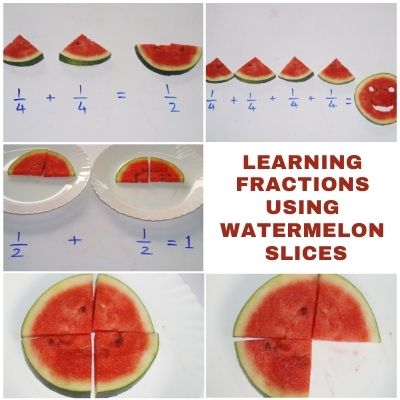
Watermelon Sensory Play
This activity is the simple and sensory play activity among all the other activities mentioned in this post.
Watermelon is the most favourite summer staple fruit and I think almost all of you are fond of it. Children will love to eat and enjoy spitting seeds out of their mouth. Water melon is great material for sensory activities as well. Yes, it provides hands-on fun and learning experience to children amazingly.
Materials Required
- Watermelon
- A scoop or a spoon
- Knife
Instructions to Do
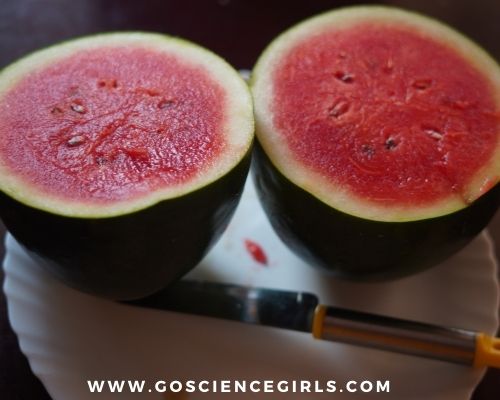
Slice the oval shaped regular watermelon in to two equal halves. Such that you can see bowl shaped watermelon halves on your experiment table.
Hand over a melon baller or a spoon or an ice cream scooper and a watermelon bowl (nothing but the watermelon half part).
Then, ask your child to scoop out the inside part of watermelon and make different sized balls. .
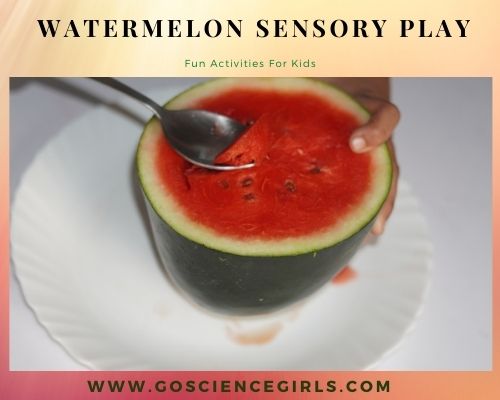
Let him/her scoop it until they finish everything inside the watermelon and see the white part of the rind.
Instruct them not to leave any juice or flesh inside the watermelon bowl. Finally, you will end up seeing an empty watermelon bowl.
That’s it! This activity looks simple and easy but helps children learn a lot of things during their sensory play with watermelon.
Learning by Playing with Watermelon Slices
Kids love to play with watermelon slices more than eating.
Here are a few examples or ideas on how children learn while playing.
- As a sensory play, offer your child a large piece of watermelon slice and a kid friendly tools. And ask him/her to chop the slice into small and different shaped pieces.
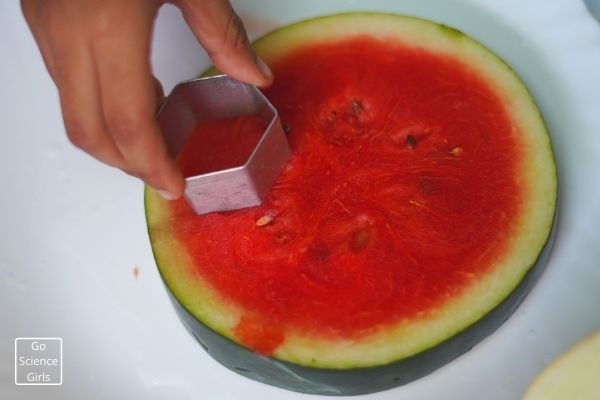
- Instruct your child to scoop out the watermelon bowl and cut the rind into blocks. They can also use these blocks for painting activity. All they need to do is dip the block into the paint and stamp it over the paper.
- Offer children a small and large sized watermelon slices and ask them to count how many number of seeds a slice can accommodate based on its size. Such that they will learn about counting and sizes.
- Place a few small pieces of watermelon in a large bowl and ask your toddler to squish it with a potato masher. Such that they will enjoy watching how water is released from watermelon while squishing.
Shape Activities with Watermelon
Learning art with watermelon is a creative and educational way to create the shapes you wish for.
Materials Required
1) Watermelon
2) Craft sticks or skewers or tooth picks
3) Moulds or cookie cutters
4) Knife
Simple Instructions to create shapes creatively
Step-1:
Cut the regular watermelon into half using a sharp knife.
Step-2:
Pick the half sliced watermelon and ask your child to have right balance while holding the melon.
Once your child get hold of balancing semi-circle shaped watermelon, then offer him/her a set of cookie cutters or molds.
Instruct them how to hold a mold and create shapes on the watermelon flesh.
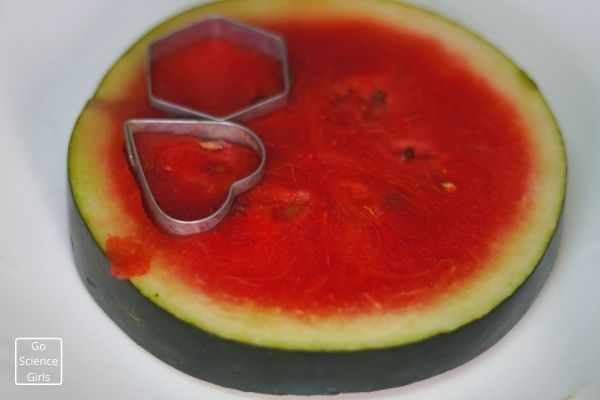
Your fingers are the best holders to bring your shapes on to a plate.
My children used heart, round, flower, square, triangle, and a hexagon shaped molds and created good-looking shapes.
Step-3:
Once your child create different and unique shapes out of watermelon flesh, attach them to the craft sticks or tooth picks or wooden skewers.
It is up to you to choose the holders to your shapes. That’s it! You are ready with a handful of watermelon lollypops.

Creating shapes is a great fine motor skill for your child! Ask your child to identify the shape names such as triangle, square, hexagon, heart.
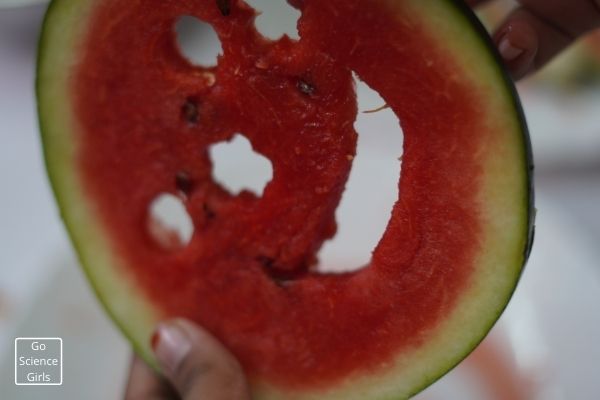
Watermelon Taste Science Activity
Watermelon taste science activity is a perfect activity to improve and analyse a child’s sense of taste.
What is Taste?
Our mouth consists of a number of taste receptors on the tongue. These receptors react chemically when our tongue receives any substance or liquid on it. Here is when the taste is stimulated and realised. It is actually a perception of individual’s taste receptors.
The seven different types of tastes that humans perceive include: bitter, sweet, sour, cool, salty, meaty, and hot.
What you need to do this sensory activity?
We do not require much efforts or material to perform this simple sensory activity. Here is what you need:
1) Regular Watermelon
2) Canary Watermelon
3) A notebook and pen to note down your recordings
4) A blind fold
Instructions to follow
Step-1:
Make sure you are having more than two number of players. Even if you have one player is also fine. However, when you have more number of players, ask them to divide themselves in to two groups.
Step-2:
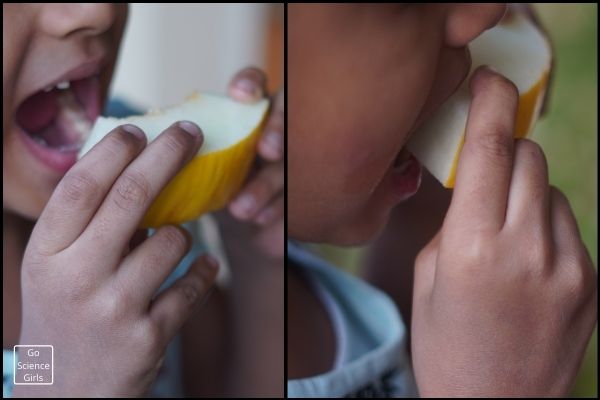
Then, slice the both types of watermelons and give the players to taste it. Give them some time to analyse the kind of taste they are experiencing.
If you find more varieties in watermelon fruit, you can offer those slices as well to players to find the taste.
Step-3:
Now, ask each player to tell their analysis on the taste of watermelon slices that are in two varieties. Also, ask them to make the differences between the slices of watermelon varieties. Once they are done, let them write their observations on a paper or notebook in the form of a table.
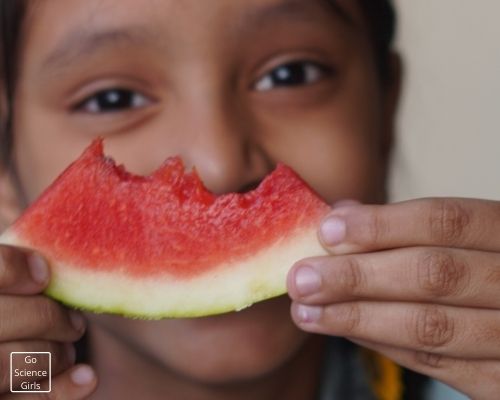
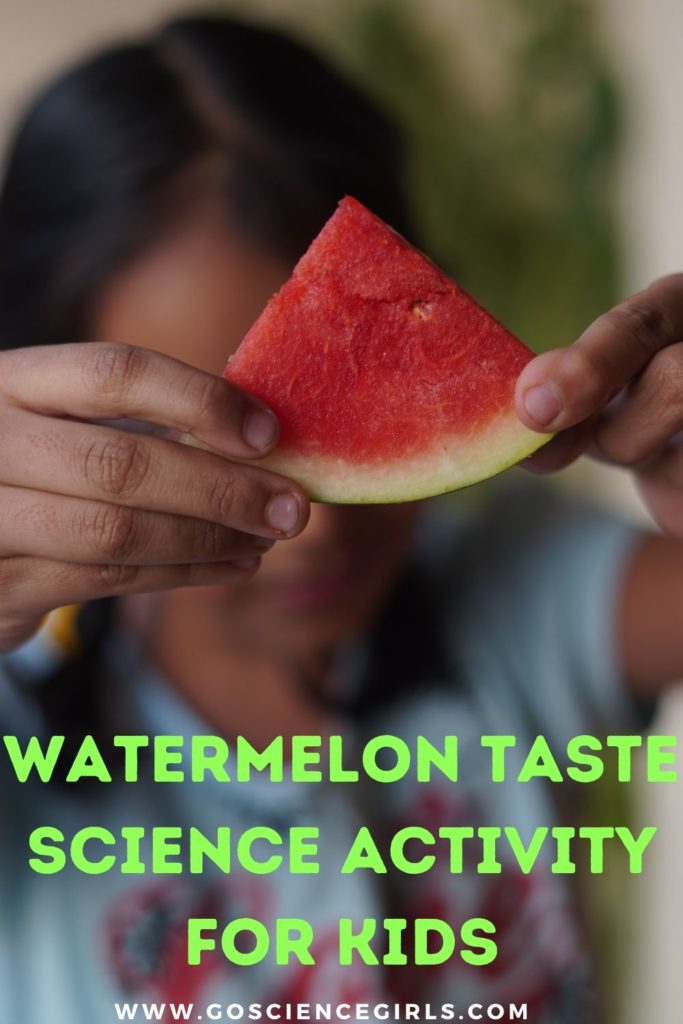
Step-4:
The next step is to blind fold the players and offer them different varieties of watermelon slices. Give them some time to analyse the taste of watermelon slices that went in their mouth. Then, ask them to reveal the tastes they experienced while tasting the melon slices.
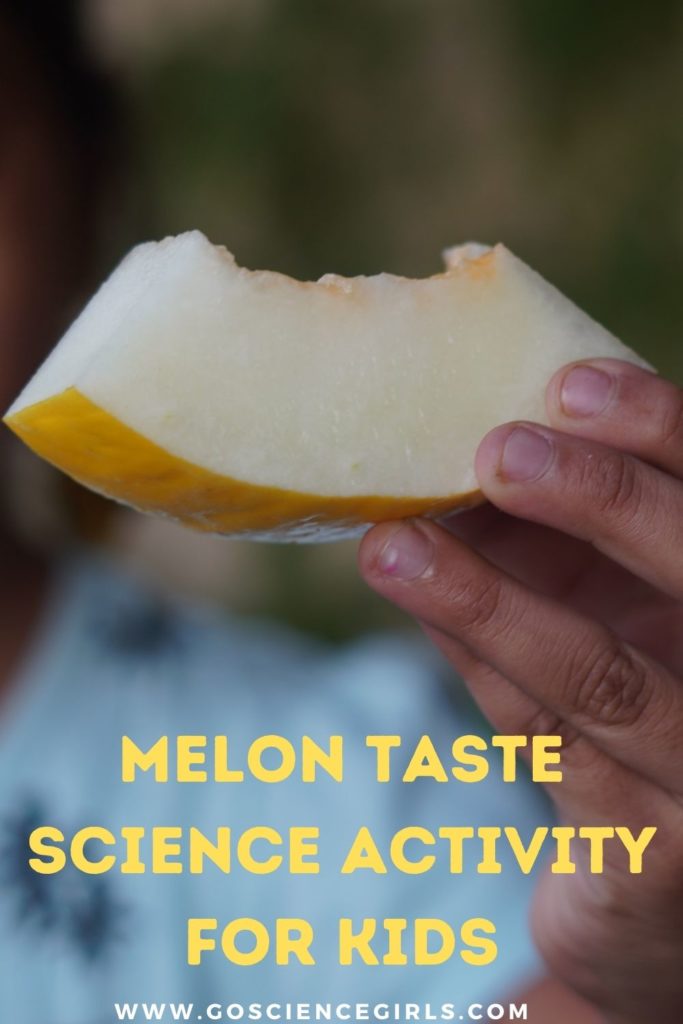
As the players are blind folded, help them to note down their analysed tastes while telling out on a paper or note book same like earlier step.
Step-5:
Now, remove the blind fold and instruct the players to find out the differences between the tastes analysed with and without blind fold. The recorded data is helpful for players to cross check their answers.
Tasting Science
Both the regular and champagne watermelons are completely natural and sweeter in taste. Also, both the melons are available in seedless and with seed varieties. So, you can ask your children to analyse the texture and check whether there are seeds or not when they taste melon slices.
Lycopene is the phytonutrient which helps regular watermelons to get red color. There are many health benefits if you consume this lycopene. These benefits include improving heart health, reducing the risk of developing cancer, and maintains prostate health. But keep in mind that when you consume watermelon in excess, you may suffer from gastro intestinal distress.
Coming to yellow watermelons, there is no lycopene. But beta carotene replaces lycopene in champagne watermelons. These beta carotene is a rich source of various healthy minerals such as iron, magnesium, potassium, phosphorous, calcium, etc.
However, both the two varieties of watermelon are fully loaded with water content which keep your body and skin hydrated for long time.
In this way, you can have simple and classic varieties of watermelon activities that are easy to perform with your children right from toddlers to older aged. Happy Experimenting!
